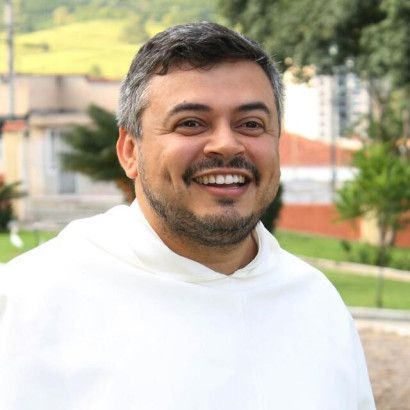This weekend, the center of Rio will host a Catholic ceremony that was created in the 13th century, by the almost millennial Order of Saint Dominic. This is the Mass in the Dominican Rite, which will be celebrated by the Friar José Almy Gomes, who has been a member of the Order for over 20 years, at the Church of the Brotherhood of Nossa Senhora da Lapa dos Mercadores, on Rua do Ouvidor, close to Arco do Teles. The Eucharistic celebration, which will take place at 10:15 am on Sunday (28/4), will be accompanied by the brotherhood’s historic bellows organ – which dates back to 1873 – and by three sacred singers in the elliptical temple that was restored and reopened last year. The conductor and singer Thiago Debossanwho plays and sings, will be responsible for the Gregorian chant during the Holy Mass.
The little baroque church built between 1743 and 1750 has been packed every weekend with its Solemn Masses, always celebrated with a Choir and Grand Orchestra, at noon. Right after the Mass of Frei José Almy in the historic rite, the already traditional Solemn Mass celebrated in the Rite of São Paulo VI, in Latin, will normally take place, accompanied by the Astorga Choir, by the lyrical singer Juliana Sucupira. It will be the first time, probably in more than a century, that the traditional Dominican rite will be prayed at that altar, just before the traditional Midday celebration. The Brotherhood of Merchants has specialized in carrying out traditional ceremonies and praising popular devotions, such as the blessing of chalk in the ceremony of the Epiphany of the Lord, or the blessing of Saint Blaise on the throats of the faithful, occasions when no more people could fit inside the small temple. with just 125 seats. The Ramos procession carried out through the historic and anthological Arco do Teles, which ended with the solemn opening of the doors of the temple that was hit by a cannonball in 1893, was another highlight.
The region is full of restaurants, bars and lots of fun, not to mention the various Museums and Cultural Centers that surround the location, which is an important cradle of Carioca culture. After Mass, there is plenty to do, and delicious delicacies to try – from Dona Dora’s pork rinds, next to the Church, at Bar Sampaio, to the incomparable feijoada at Sobrado da Cidade, a little further along on Rua do Rosário, which recently gained the Tucum store, specializing in beautiful indigenous crafts.
The Rite and its Differences
The Dominican rite is similar to what is conventionally called “tridentine mass“, but there are specific differences and it is rare to be seen here in Rio; in the United States, it has grown and is being performed in several churches. There are many differences between the Dominican liturgy and the Roman liturgy established by Saint Pius V – the so-called “Tridentine”, today treated as Extraordinary Rite within Catholicism. The main difference between the Dominican and the Roman Rite is in the way a low Mass (those that are not ‘solemn’) is celebrated. In the Dominican Rite, the celebrant wears the amito on his head until the beginning of Mass and prepares the chalice as soon as he arrives at the altar. He doesn’t even say “I introduce ad altare Dei” not the Psalm “Judge me God”instead, it says “Confitemini Domino quoniam bonus”with the altar boy responding “Quoniam in saeculum misericordia ejus” (“Praise the Lord, for He is good; For his mercy endures forever.“). The Confiteor is much shorter than the Roman and contains the name of Saint Dominic, founder of the Order.
The Glory and the Creed begin in the center of the altar and end in the Missal or at the president’s headquarters. In the Offertory, there is a simultaneous offering of the Host and the chalice and only one prayer, the “Suscipe Sancta Trinitas”. The Canon of the Mass is the same as that of the Roman Rite, but the priest holds and gestures with his hands and arms differently — for some parts of the Canon, his hands are folded and immediately after the consecration, he holds his arms in crucifix position. The words of the Consecration are different from those of the Roman equivalent.
The Dominican celebrant also says the “Agnus Dei” immediately after the “Pax Domini” and then recite the prayers “Hæc sacrosancta commixtio”, “Domine Iesu Christe” It is “Corpus et sanguis”, after which Communion follows, the priest receiving the Host from his left hand. No prayers are said at the consumption of the Precious Blood, the first prayer after the “Corpus et Sanguis” being Communion.
At a solemn Mass, the chalice is brought in procession to the altar during the Gloria, and the corporal is unfolded by the deacon during the singing of the Epistle. The chalice is prepared immediately after the subdeacon has sung the Epistle, with the ministers seated on the Epistle side of the sanctuary. The chalice is brought from the altar to the place where the celebrant is sitting by the subdeacon, who pours the wine and water into it and replaces it on the altar. During important feasts, a procession takes place to offer the gifts to the deacon during the offertory — a gesture not found in the Tridentine Missal, but which was made in the first liturgical rituals and was restored in the most recent reforms of the Roman Rite by the Pope Saint Paul VI. The incense of the ministers occurs during the singing of the Preface. Throughout the rite, ministers also stand or move in different patterns, quite different from those of the ancient Roman Liturgy.
Apart from the differences in the Mass, the Dominican Breviary also differs a little from the Roman one. The Offices celebrated are of seven classes: of time (de tempore), of saints (de sanctis), of vigils, of octaves, votive offices, Office of the Blessed Virgin and Office of the Dead. The order of the psalms is different from Roman usage in the canonical hours, with Prime having a different selection of psalms, and the Easter season providing only three psalms and three lessons instead of the customary nine psalms and nine lessons. The Office of the Blessed Virgin is said on all days when feasts of the degree of duplex or “totum duplex” are not celebrated. The Gradual Psalms are said on every Saturday on which the votive office of the Blessed Virgin is said and were added to the Prime psalms during Lent. The Office of the Dead is said once a week, except during the week following Easter and the week following Pentecost. Other minor points of difference are the way of carrying out the celebrations, the text of the hymns, the antiphons, the lessons of the common Offices and the insertions of special feasts of the order.

The priest has a degree in Philosophy from Universidade São Francisco (1993), Theology from the Dominican School of Theology (1999) and a master’s degree in Theology and Patristic Sciences – Instituto Patristico Augustinianum (2007). Currently, the priest is a professor of Patristics (study of the so-called “fathers of the Church”), introduction to classical languages, History of the Medieval Church at the Dominican School of Theology. Professor of Fundamental Theology, Creation Theology of courses offered by the Nossa Senhora do Carmo School of Theology – Itaquera. Patristic Theology at EDT – Sagrada Família and a free course on Saint Paul for Church priests at EDT – Perdizes.
Service
SOLEMN MASS IN THE DOMINICAN RITE
With Gregorian Chant and Organ – Maestro Thiago Debossan
Celebrant: Friar José Almy, OP
Sunday, 4/28 – 10:15 am
(The following mass, with Choir and Orchestra, at 12pm, is maintained and will take place at 12:20pm)
Church of Our Lady of Lapa dos Mercadores
Rua do Ouvidor, 35 (corner of Travessa do Comércio)
No need to book
Nearby parking lots: Menezes Córtes Terminal, and around the Stock Exchange Building (Praça XV)
Transport: Carioca Metro, or get out of the car/bus at Primeiro de Março and walk along Rua do Ouvidor to the Church, towards the sea
Warning

Warning

Tags: Catholic ceremony #13th century celebrated Center Dominican friar Gregorian Chant
--








